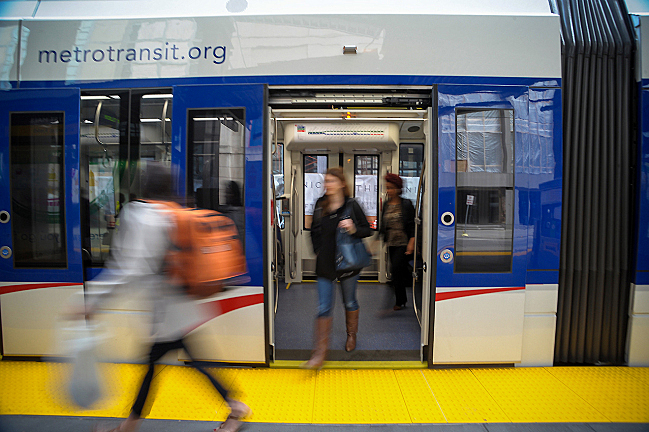
A writer on Streets.mn today pretty much declares the Green Line a failure.
“The new train will result in poorer service,” David Markle writes in today’s post on the transportation-centric blog.
Since the end-to-end speed of the light-rail line from St. Paul to Minneapolis was announced a few weeks ago, supporters and opponents have lobbed grenades over the time it takes, roughly the same as the Route 16 bus. If you’re lucky.
During construction, I’d intended to take the line to Target Field for the July 4th game vs. the Yankees. But when push came to shove, and with four people in the car, it made more sense to just drive into town.
Part of that decision is owed to the 55 minutes it took to get from 10th Street in St. Paul to the Nicollet stop in Minneapolis when we tried the new line out on the weekend of Rock the Garden.
More often, we hear “it takes too long” among potential riders. There’s a good reason for that. It takes too long.
In his post, Markle pulls no punches when it comes to evaluating the decision makers.
Light rail vehicles (LRVs) appropriately function as commuter lines and connectors for long urban distances. To fulfill that purpose efficiently they should either operate along limited access highways, or along existing rail right of ways, or in tunnels, or on elevated structures.
In contrast, if the purpose were to provide surface rail service on University Avenue, a modern streetcar line would seem the obvious choice, not a train. Streetcars run with the automotive traffic and often stop at corners to pick up and discharge passengers. A modern streetcar closely resembles a single LRV.
A University Avenue streetcar should travel at nearly the same speed as the 16 bus. At the time of Central Corridor planning, few cities pursued aid for streetcar development, but at a cost per mile of about 1/3 that of LRT, installing a streetcar line would have cost state and local government significantly less than the roughly 50% match needed to get the federal LRT dollars.
But the decision makers didn’t understand the difference between streetcars and trains; consequently we’ve got a train that can’t run as a train should (to get commuters off the freeway and provide rapid point to point transportation) and yet can’t provide the good local service of a streetcar.
At this point, we should recognize the unequivocal advantages of the Green Line over local bus service: 1) easier, more frequent service between the University of Minnesota main campus and Downtown Minneapolis; 2) easier physical entrance to and exit from LRVs, compared to buses; 3) brighter and shinier than buses. But these would be advantages of a modern streetcar line as well!
Markle acknowledges the line will attract riders, but he says the line will be at capacity in only 15 years and we still won’t have a speedy alternative to a clogged Interstate 94 for getting from St. Paul to Minneapolis. He calls it “transportation strangulation.”
So far, the magnitude of the Green Line transit fiasco—a nearly $1 billion expenditure for what’s probably the most expensive public works project yet completed in Minnesota—hasn’t dawned on the public.
In the current blizzard of adulation, optimism and self-congratulatory publicity, it’s not yet clear for the public to see the Green Line’s failure to provide a vital regional transit trunk line between our two major cities.
If anything, the Green Line presents a distorted model that encourages some to clamor for Southwest Corridor LRT service in Uptown without demanding tunneling or elevation of the line so as to preserve rapid transit train function in a dense area.
Markle says the area is “without strong leaders who perceive and understand issues, forthrightly admit errors, and wisely advocate better ways.”
Disclosure: Minnesota Public Radio and the Metropolitan Council are negotiating ways to reduce noise and vibrations from the newly built light rail line outside MPR headquarters under a contract agreed to in 2009. riders.
